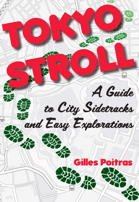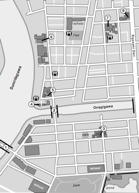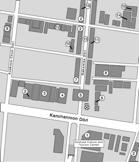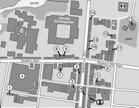











Tokyo Stroll Supplement: Inagi

This page is for locations in the Inagi area of Tokyo. This town is not part of my book Tokyo Stroll.
For information on Tokyo Stroll and this web supplement see Tokyo Stroll Supplement home page
For users of the Organic Maps, Maps.Me and Google Maps apps the items below have bookmarks you can import into those apps to make navigation easier.
Instructions and links are on the Viewing Locations in Organic Maps, Maps.Me, Google Maps, or Google Earth page.
Some entries on this page may include a note that says "Description to be added soon ." These entries are for items I felt should be listed even if the description is not ready to assist those who wish to plan a trip. When possible I included a link to an official web page, I suggest also doing web searchs for more information.
Inagi-shi (稲城市)
In 1889 the villages of Yanoguchi, Higashi Naganuma, Daimaru, Hyaku, Sakahama, and Hirao were merged to form Inagi village. In the 1960s through 80s Inagi became part of the massive Tama New Town residential development project to create housing for hundreds of thousands of Tokyo residents.
Official pages for each of the cities and towns of will have sections of interest to visitors. These will likely be labeled as dealing with culture, tourism, or events.
Inagi Shi official site: https://www.city.inagi.tokyo.jp
Anazawa Tenjinsha (穴澤天神社)
The oldest shrine in Inagi said to have been founded in the reign of the legendary Emperor Kōan, mention of the shrine goes back to the a Heian Period document the Engishiki Jinmyocho. Anazawa Tenjinsha is south of the Misawa river and on the edge of a large forested hill commonly referred to as Tenjinyama. The current building dates back to 1694 with various sub shrines and a kagura stage. The grounds includes a fudezuka (a calligraphy brush burial mound) in honor of Edo Period calligrapher Harada Kinryō, caves, and a spring which is one of the 57 Famous Spring Waters of Tokyo. The main kami enshrined here are Sukunahikona no Mikoto, Sugawara no Michizane, and Ōnamuchi no Mikoto. People pray here for help in matchmaking, learning, health, and performing arts. During the annual festival there are performances of Edo no Sato Kagura and the Anazawa Tenjin Shrine Lion Dance.
NEAREST TRAIN/SUBWAY STATION: Keiō Yomiuriland Station (Keiō Sagamihara Line)
EVENT: Annual festival, August 21-25
WEB: http://www.tokyo-jinjacho.or.jp/Minami-Tama/inagi/6070/
X: https://x.com/anasawatenjin
INSTAGRAM: https://www.instagram.com/anasawatenjin/
Arigatayama (ありがた山)
An unusual collection of well over 4,000 abandoned grave markers and roadside statues such as those of Jizō and Kannon at the top of a steep hill. After the 1923 Great Kantō Earthquake Bunkyō ku in Tokyo had many such abandoned grave markers. Starting in 1939 a charity organization began relocating them to this site using a verity of means to transport them such as handcarts and small three wheeled trucks.. It is said that they chanter arigatō, "thank you," as they carried them up the hill resulting in the current name of the location. Today locals keep the area weeded and cleaned.
NEAREST TRAIN/SUBWAY STATION: Keiō Yomiuriland Station (Keiō Sagamihara Line)
ACCESS: This one takes some hiking to get to. If you go west on the road to the south of Myōkakuji and follow the path going south near the end of it after a bit you will go through a local cemetery, beyond that you will eventually reach Arigatayama.
Batō Kannon Towers / Batō Kannon tō (馬頭観世音塔)
On this old ferry road which led to the Yanoguchi ferry there is a row of Batō Kannon, Horse-headed Kannon, roadside monuments. The oldest date from the Edo Period, the newer ones from the Shōwa period. Some have a bas relief of Batō Kannon, most just have the name inscribed. Such stones would be set up in memory of a beloved horse or as a prayer for the safety of travelers. This group of stones is also sometimes called the Old Ferry Road Hayagrīva 14 Groups (旧渡船場道 馬頭観世音塔)
NEAREST TRAIN/SUBWAY STATION: Yanokuchi Station (Nambu Line)
Gundam manhole cover
A manhole cover showing the head of the title mecha from the original Gundam TV series. The location is on the south side of Inaginaganuma Station next to the north west corner of Inagi Pear Park.
NEAREST TRAIN/SUBWAY STATION:Inaginaganuma Station (Nambu Line)
Gundam Monument (ガンダムモニュメント)
Two statues, roughly 3.6 meters tall, of mobile suits from the original Gundam TV series which were unveiled in April 2016 as part of the opening of the Inagi Information Base Pear Terrace. The statues are of Amuro Ray's Gundam and Char Aznable's red Zaku. Ōkawara Kunio, who was born and lives in Inagi, was the designer of both mobile suits. Attending the unveiling ceremony were designer Ōkawara, Furuya Tōru who was the voice of Amuro Ray, and Ikeda Shūichi the voice of Char Aznable.
NEAREST TRAIN/SUBWAY STATION: Inaginaganuma Station (Nambu Line)
Inagi Information Base Pear Terrace / Inagi Hasshin Kichi Pear Terrace (いなぎ発信基地 ペアテラス)
The Inagi Information Base Pear Terrace opened on April 23, 2016. Tourism information, a gallery for displays, a small cafe and local specialty items from Inagi and sister cities.
NEAREST TRAIN/SUBWAY STATION: Inaginaganuma Station (Nambu Line)
WEB: https://www.city.inagi.tokyo.jp/kanko/kanko_tokusyoku/inagihasshinkichi_pearterrace/pearterrase.html
Myōkakuji (妙覚寺)
This forested hillside temple dates from the Muromachi period. The grounds are planted with a variety of trees, including plum trees, and with hydrangea. Statuary and stone monuments are also scattered about the grounds.
ACCESS: The entrance is on the east.
NEAREST TRAIN/SUBWAY STATION:Keiō Yomiuriland Station (Keiō Sagamihara Line)
Myōkenji (妙見寺) and Myōkenson (妙見尊)
Located on a forested hill Myōkenji and Myōkenson are a rare combination of a hybrid institution which was far more common before the Meiji Period forced separation of Buddhism and Shintō. The names of the temple and shrine refers to Myōken, a deification of the North Star who is considered a bodhisattvā in Buddhism. The Tendai Sect temple Myōkenji was founded in 1112. The main hall of the temple is wood with a copper roof, the main image is of Amida Nyorai. Nearby there is a torii at the base of a flight of stair heading to Myōkenson. Myōkenson is said to date from 760 AD with views of Inagi city center and the Tamagawa, the shrine is also called Hokushin Myōkenson. This shrine is known for the annual Hebiyori-gyōji " Snake Ceremony" an Inagi City Cultural Property and later designated by the Tokyo government as a intangible folk-culture asset in 1992. A 100 to 150 meter long snake is made from kaya branches. Touching the serpent is consider a charm against bad luck and illness. Legend has it that Myōken appeared here riding a blue dragon in the 8th century.
NEAREST TRAIN/SUBWAY STATION: Inagi Station (Keiō Sagamihara Line)
ACCESS: Entrance from the north.
EVENTS:
January 8th, Shinka Festival.
June 2nd Sunday, Segaki Ceremony.
August 7, Hebiyori-gyōji " Snake Ceremony" .
Descriptions and other events are listed on the web site. .
PILGRIMAGE: Tamagawa Thirty-Three Kannon Pilgrimage temple #30 [need to verify pilgrimage name and list of other temples] .
WEB: https://myoukenji.or.jp
Scope dog (スコープドッグ)
A full sized, 4 meter, statue in Inagi Pear Park of a Scope Dog from the Armored Trooper VOTOMS anime series. The statue was unveiled in front of Inaginaganuma Station on March 2020 as part of an effort to revitalize the Inagi area. Ōkawara Kunio, who was born and lives in Inagi, was the designer of the Scope Dog. Series director Takahashi Ryōsuke and mechanical designer Ōkawara Kunio attended in unveiling.
NEAREST TRAIN/SUBWAY STATION: Inaginaganuma Station (Nambu Line)
Yatterwan (ヤッターワン)
Located just north of Minami-Tama Station this statue of the character from the Yatterman TV anime series was installed in April 2017. The 2 meter, 6.6 foot, tall statue was donated by Nippon Filcon as part of a celebration of the centennial of the company's founding. The designer of Yatterwan is Ōkawara Kunio, who was born and lives in Inagi. Ōkawara and Yamadera Kōichi, who was the voice of Yatterwan, attended the installation ceremony.
NEAREST TRAIN/SUBWAY STATION: Minami-Tama Station (Nambu Line)
Yatterwan manhole cover (ヤッターワン)
A manhole cover with a colorful image of Yatterwan. This is located at the west end of the sidewalk along the south side of Minami-Tama Station.
NEAREST TRAIN/SUBWAY STATION: Minami-Tama Station (Nambu Line)
Yomiuri Land (よみうりランド)
The largest and most famous amusement park in Tokyo which opened in 1964. The park is so large it spans the border between Tokyo and Kanagawa Prefecture spreading into Kawasaki. Besides the rides and activities there are shops and restaurants scattered throughout the park. During the fall and winter evenings the park is known for the illumination shows that light up the area. Yomiuri Land is divided into eight areas providing a variety of activities and entertainments mainly for kids but many fun for all ages, they are:
Goodjoba‼ Area, the themes here are on Japanese craftsmanship providing outdoor and indoor activities so they can be enjoyed in all types of weather.
This area is divided into six "factories."
1. CAR Factory with a focus on the automobile industry and is a partnership with the Nissan company.
2. Food Factory partnered with Nissin Foods. The activities here are based around the Yakisoba U.F.O. product.
3. Fashion Factory, partnered with WORLD/SHIMA SEIKI a company known of is knitting products.
4. Bungu Factory, partnered with the stationary company Kokuyo which is best known for their Campus Note product line.
5. Sky Patrol, partnered with ALSOK a security company.
6. SPACE factory, partnered with Taishō Pharmaceutical Holdings and is themed around their energy drink LIPOVITAN D.
Plaza Stage of the Sun. This area has safe rides for kids.
Lan Lan Area. Here one finds rides that are a bit more thrilling, including the only bungee jumping facility in Tokyo.
Flag Street. A haunted house, a hero trailing facility, a game arcade, old fashioned carnival games, go-karts, and other rides.
Family Area. A train ride, a Ferris wheel, sea lion show, and a firefighting ride where you spray water as "fires" to extinguish them.
Bandit Area. This area is named after Bandit, the largest roller coaster in Yomiuri Land, when it opened in 1988 this was the tallest roller coaster in the world. There is also a tamer ride for younger riders called Animal Rescue
Aqua Area. A large water park, tattoos are not permitted int his area. One section designed for adults is called Night Pools and is only open in the evenings.
Gondola boarding Area. A station for the Gondola Sky Shuttle connecting the park to Keiō Yomiuriland Station.
NEAREST TRAIN/SUBWAY STATION: Keiō Yomiuriland Station (Keiō Sagamihara Line), from there one can take the Gondola Sky Shuttle or the Odakyu Bus to the park.
WEB: https://www.yomiuriland.com/en/
Back to the Tokyo Stroll Supplement home page - Privacy Notice - Back to Gilles' home page
Created July 29, 2024 | Content last updated July 29, 2025